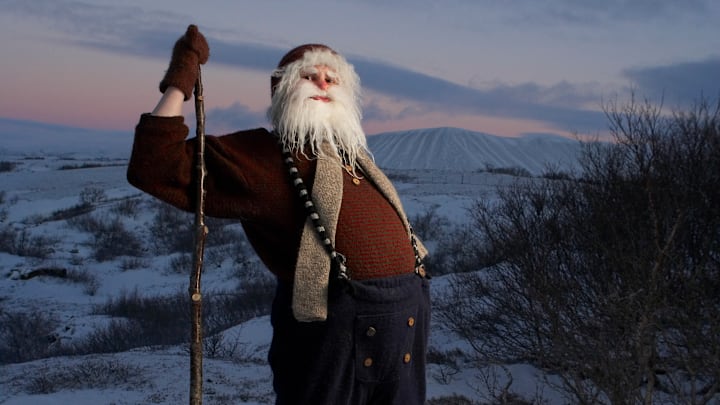Some Christmas themes are universal: be good, and you will be rewarded. Misbehave, and you’ll wish you hadn’t. Here in the United States, that reward often takes the form of giant piles of presents; the punishment, a lump of coal, or worse, no gifts at all. The idea is pretty much the same in Iceland, but the specifics are a little different. Where we have Santa, Icelandic kids can expect visits from the band of bearded wild men known as the Yule Lads.
As Jaya Saxena explained for Atlas Obscura in 2015, every year, beginning on December 12, the 13 mountain men descend from their mountain homes. They come down singly, one each night, until Christmas Eve, which means 13 full days of fear-driven good behavior.
The lads are said to be the sons of the child-eating trolls Grýla and Leppalúði. Like large, slightly unsettling versions of Snow White’s seven dwarfs, each lad has his own quirks, his own silly name, and his own demands. Spoon Licker requires a batter-covered spoon; Sheep Worrier tries to harass the sheep; and Meat Hook wants a taste of every family’s smoked lamb, which he steals with his hook. In exchange for these bribes, good children receive a small gift in their shoes each night. Bad children get a raw potato.
The Yule Lads weren’t always this cooperative. A few centuries ago, the lads and their friends Krampus and the Yule Cat bypassed the raw potatoes and went straight to kidnapping naughty children. Instead of asking nicely, they stole their milk and meat and ate people’s candles, leaving families to freeze in the dark.
The troublemakers got a makeover in 1932, when a man named Jóhannes frá Kötlum penned a jolly poem called “Jólasveinavísur.” The poem reframed the lads’ mischievous past and bestowed them with the goofy names they bear today.
These days, depictions of the Yule Lads have them dressed in red costumes, slinging big sacks of toys. In other words, the lads now look suspiciously like Santa. This is simply inaccurate, folklore expert Magnús Skarphéðinsson told Atlas Obscura: “I have met more than 800 Icelanders that have seen elves, and four or five that have seen Yule Lads. They were old fashioned dressed, poor, a little dirty, a little rude and hungry, trying to get food.”
Whether the real Yule Lads are portly or gaunt, friendly or fierce, one thing’s for sure: When it comes to coercing good behavior out of little kids, they get the job done.
A version of this story originally ran in 2015; it has been updated for 2023.
